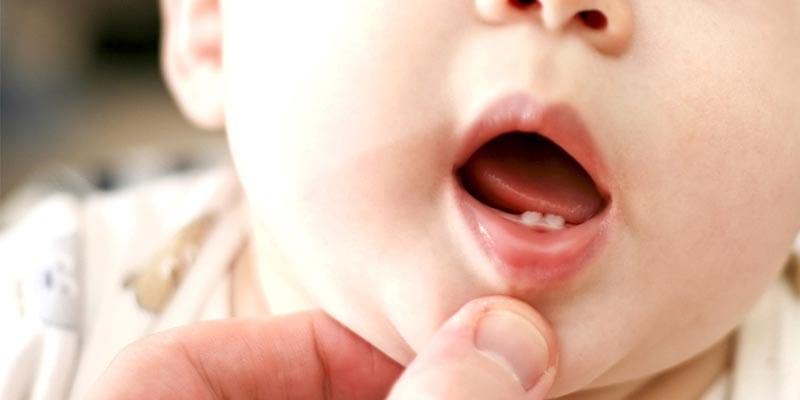Baby teeth are essential to your child’s long-term oral growth and development. Baby teeth help your child learn to chew, speak, and our favorite – smile! Baby teeth hold space in the jaws for the permanent teeth to eventually take their place.
Your baby’s 20 primary teeth are already present in the jaw at birth. Baby teeth will begin to erupt from the gums between 4-8 months. While every child’s growth and development is different, the first teeth to come in are always at the front of their mouth.
Baby Teeth: Order of Appearance

Lower Central Incisors
Typically, the first to erupt are the lower central incisors. These teeth will usually show between the ages of 6-10 months.
What to know: As your baby’s first teeth erupt, the gums will be tender. You can rub your child’s gums with a clean finger, a cool spoon, or a wet washcloth to help soothe the soreness as they teethe.
Upper Central Incisors
Who doesn’t love a baby with a two-front-teeth smile? The next teeth to show are the upper central incisors, which typically erupt between 8-12 months.
What to know: The American Dental Association (ADA) recommends scheduling your child’s first dental appointment with a pediatric dentist either when the first tooth erupts or by the child’s first birthday.

Upper Lateral Incisors
The upper teeth to the right and left of the central incisors (front teeth) are the next to erupt; this usually happens between 9-13 months.
What to know: A clean teether for your baby to chew on may help soothe them while teething. Look for teethers made of solid rubber, and avoid liquid-filled teething rings or plastic objects that could break.
Lower Lateral Incisors
The lower lateral incisors are the next pair of teeth to come in, typically between 10-16 months.
What to know: Avoid sending your baby to bed with a bottle of milk or juice. If your baby must have a bottle at bedtime, choose water. The sugar in milk and juice can create cavities.

Upper First Molars
Here come the molars! The first set to erupt will be the upper first molars, typically between 13-19 months.
What to know: At this stage, you can teach your child to brush their teeth with a pea-sized amount of fluoride toothpaste, given they can spit.
Lower First Molars
The bottom molars will arrive almost simultaneously with the upper molars, typically between 14-18 months.
What to know: By now, your baby might be introduced to cow’s milk and will need more calcium to supplement healthy bone and tooth development. Ensure that your child has a healthy diet of fruits and vegetables that are high in water content to help with oral health.

Upper Cuspid
Also referred to as canines, the upper cuspids will appear between the incisors and first molars at 16-22 months.
What to know: At this point, the ADA recommends that your child has regular bi-annual visits to the pediatric dentist.
Lower Cuspid
Around 17-23 months, the lower cuspids will erupt between the lower incisors.
What to know: As an independent toddler, your child will want to do things themselves. Now is the time to focus on a non-negotiable parent-led routine in the evenings and a more forgiving child-led brushing routine in the mornings.

Lower Second Molars
This pair of molars will typically appear between 23-31 months.
What to know: Practice makes perfect! While parents must perform a thorough brushing and flossing before bedtime, let your child be involved in the routing by holding or chewing on a toothbrush while you brush the opposite side of their mouth with another.
Upper Second Molars
The final pair of primary teeth will erupt between 25-33 months.
What to know: Early visits to the pediatric dentist allow you the opportunity to discuss brushing challenges with your dentist personally. It sets the stage for good oral care based on the unique early development of your child.
Is Your Baby Ready for a Pediatric Dental Visit?
At Jenkins Dentistry for Kids, we understand that children need specialized care. With over 15 years of experience treating and providing dental care to infants, toddlers, adolescents, and children with special needs, our doctors are board-certified, having completed further education requirements to specialize in children’s oral health needs.
Is your baby’s smile a little less gummy these days? We can’t wait to meet you! Request an appointment here.

